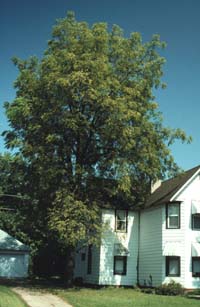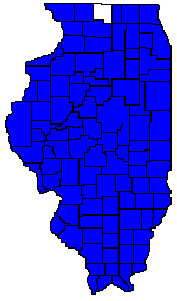 |
| Black
Walnut (Juglans nigra)
Distribution
Map to Right |

Black walnut is a tall tree, reaching heights of 150 feet, with a trunk diameter of 2-5 feet. It is also referred to as eastern black walnut and American walnut. The trunk is straight and the crown is broadly rounded. This tree is highly prized for its beauty and the quality of its wood.
It grows on a variety of sites in the central and eastern portion of the United States. In Illinois, black walnut grows along streams, on the slopes adjacent to the floodplains and in rich woodlands. It is widespread throughout Illinois. It prefers deep, rich, well-drained soils that hold enough water so that it is available to the tree during dry intervals during the growing season. Most of these soils are sandy loam (organic rich) or silty loam (organic rich) soils. It is common on limestone soils and grows well along streams, but not on wet or saturated bottomlands or extremely dry, sandy soils of ridges.
Interesting
Facts
Black
walnut is a highly prized and beautiful tree, and large specimens have
been nearly eliminated (harvested) in some parts of the country. They are
scattered throughout mesic forests and occasionally occur in small, pure
stands only at the periphery of these forests.
Black walnut leaves, bark, nut husks, and roots contain "juglone," a chemical that is lethal to and prevents the growth of many other plants within the tree's rooting zone. Paper birch, red pine, white pine, Scotch pine, and apple are reportedly sensitive to this toxin. Tomatoes are especially affected by the substance and will not grow near large black walnut trees. Bruised nut husks were formerly used to kill fish for consumption until the practice was made illegal.
Identifying Features
Bark
Black walnut bark is black, thick, and deeply grooved.
Twigs
The twigs are stout, smooth, and greenish brown or gray.
Buds
The buds are whitish, woolly, more or less rounded at the tip, and up to 1/2 inch long.
Leaves
The leaves are large (12 - 24 inches long), alternate, and pinnately compound with 17 - 25 lanceolate leaflets. The leaflets are toothed at the edges, pointed at the tip, and up to 3 1/3 inches long and 1 1/2 inches broad. The base of the leaflet is asymmetrical. Leaflets are yellowish green and smooth on the surface, paler and slightly hairy underneath, especially along the veins.
Flowers
Black walnut is monoecious, with separate male and female flowers occurring on the same tree. Flowers appear in April - June. The female flowers (pistillate) are without petals occur a few clustered together in small spikes. They are relatively inconspicuous. The male flowers (staminate flowers) occur as several together in hairy catkins that are greenish yellow.
Fruits
Fruits are borne singly or in pairs. They are spherical, up to 2 inches in diameter, with a thick, warty husk that is entire (unlike the black hickory, in which the husk is split into four sections when the fruit is ripe). The nut husk is very hard and the seed wonderfully sweet (The walnut grown commercially in California is Juglans regia. Native black walnut is also very tasty - particularly when made into a paste and eaten on a sandwich with honey, as one would peanut butter). The seeds (nuts) have prominent longitudinal grooves and are warty and dark brown. They ripen in October - November.
Uses
Black
walnut wood is one of the most desirable for cabinets, veneers, furniture,
and interior finishing. It is hard, heavy, coarse grained, very attractive,
and easy to work with. It is also used for gunstocks. The bark is used
for tanning and the nut husks have been used as a toxin for fish (currently
illegal), and for yellow-brown dyes. The nuts are a food source for humans,
squirrels, mice, and other wildlife. The twigs are browsed by deer. Native
Americans used black walnut medicinally to treat skin disorders and as
a psychological aid.